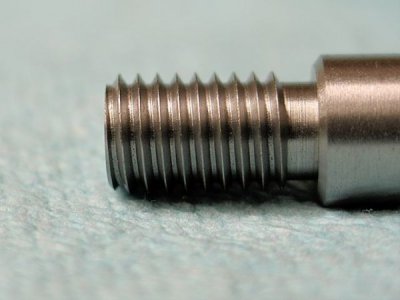I was searching my computer for a pic of a screw with the features I mentioned - chamfer, thread relief. I couldn't find the one I was looking for but I found this one and I hope it sort of gives you an idea of what I meant. This is an 8mm Class 3 thread in 1144 Stressproof steel. It has a 30 degree chamfer at the end X 1-1/2 threads (most of it is on the other side of the screw - sorry) and a thread relief. It was cut with a Rex AAA cobalt HSS threading tool with 15 degree relief angles and the thread is as it comes off the lathe, no filing or anything. The thread relief is about 2-3 threads wide and ends in a clean shoulder; made with a P1-N parting tool. For those of you with calibrated eyeballs, the depth of the thread relief is 0.003" deeper than the minor diameter.
Hope this makes things clearer.
View attachment 274376


